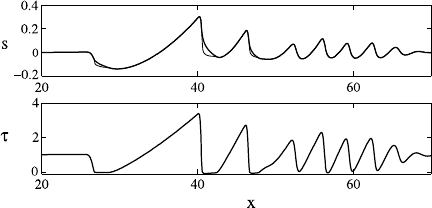Fowler A. Mathematical Geoscience
Подождите немного. Документ загружается.


320 5 Dunes
(the depth scale of the flow d is denoted L in the Hunt paper). The small parameter
δ in (5.284) is defined on page 1,449, two lines above (3.7a)
H
:
δ =
1
ln
l
z
0
. (5.287)
It is convenient to define
l =2κεΛd, (5.288)
and then we have
Λ =
1
1 +
ε
κ
ln2κεΛ
≈1 −
ε
κ
ln2κε, (5.289)
and
δ =
εΛ
κ
. (5.290)
Using these results, we find that the dimensionless Hunt formula for the basal
shear stress can be written as
τ =1 +εB
1
+ε
2
H
2
+···, (5.291)
where
B
1
=−2H(s
x
), (5.292)
as in (5.198), and the transform of H
2
is
ˆ
H
2
=
ˆ
B
1
κ
{−2ln2κε +2lnk +4γ +1 +iπ}. (5.293)
We can now compare the results with the formula derived in 5.7. The formulae
(5.197) and (5.291)differintheO(ε
2
) coefficient, and these are related, assuming
−k =|k|e
−iπ
(as is required: see the comment following (5.188) and its accompa-
nying footnote), by
B
2
=H
2
+C, (5.294)
where the transform of C is defined in (5.200). The difference between the two
versions of the theory lies in the way in which the Reynolds stress terms are treated
when they occur at second order. Since it is the second order terms which provide
the instability, we see that the matter of their computation is of some importance.
The difference presumably arises because Jackson and Hunt do not make explicit
their assumption on the Reynolds stress away from the boundary.
The Herrmann Model The principal exponent of dune modelling is Hans Her-
rmann, and there is also a thriving French school under the aegis of Bruno Andreotti.
The basis of the Herrmann approach is in the papers by Sauermann et al. (2001) and
Kroy et al. (2002a, 2002b), which last is simply a more complete exposition of their
earlier paper. The Herrmann model is essentially an Exner–Hunt model, that is to
say that the Exner model s
t
+ q
x
= 0 is combined with a Bagnold-type transport

5.9 Notes and References 321
law q = q
0
(τ ), in which a lag is included to represent the finite acceleration of the
transport, thus, essentially,
l
s
∂q
∂x
=q
0
−q, (5.295)
and finally the stress is computed using Jackson–Hunt theory. From (5.291), (5.292)
and (5.293), we can write the transform of the stress perturbation, τ
1
=τ −1, in the
form (assuming k =|k|e
−iπ
when k<0)
ˆτ
1
=ε
A|k|+iBk
ˆs, (5.296)
where
A =2
1 +
ε
κ
2ln
|k|
2κε
+4γ +1
,
B =
2πε
κ
.
(5.297)
Kroy et al. (2002b) give the same formula (5.296) (their Eq. (12), the extra ε
arising when their formula is made dimensionless), but their definitions of A and
B are not quite the same, although also based on the Hunt formula. The values
are similar though; based on values |k|=1, ε = 0.03, κ = 0.4 corresponding to
d
z
0
= 0.6 × 10
6
, we calculate A = 3.6, B = 0.47, compared to the typical Kroy
values A ≈4, B ≈0.25.
The linearised Herrmann model for the transforms of the perturbed variables
takes the form (cf. (5.201), (5.295) and (5.296))
μik ˆq =q
0
ˆτ −ˆq,
εˆs
t
+ik ˆq =0,
ˆτ =ε
A|k|+iBk
ˆs,
(5.298)
where the relaxation length parameter μ is
μ =
l
s
d
, (5.299)
and is small. With ˆs ∝e
σt
, we obtain
σ =r −ikc =
−ikq
0
(A|k|+iBk)
1 +μik
, (5.300)
and thus the growth rate is
r =
q
0
k
2
(B −μA|k|)
1 +μ
2
k
2
, (5.301)
and the wave speed
12
is
c =
q
0
(A|k|+μBk
2
)
1 +μ
2
k
2
. (5.302)
12
The wave speed is −Im σ/k here because the Fourier transform is defined with e
−ikx
.

322 5 Dunes
Fluvial Versus Aeolian? The Herrmann version of the theory is very attractive
because the relaxation length causes the growth rate to become negative at large
wave number. This is likely relevant for aeolian dunes, but less relevant for fluvial
dunes, where one might expect μ to be tiny. However, the instability relies on the pa-
rameter B>0, and if the downslope term in (5.224) is included, then the definition
of B in (5.297)
2
is modified to
B =
2πε
κ
−
ˆ
β
ε
, (5.303)
indicating B<0 and stability. The constant eddy viscosity (Benjamin) model does
not suffer this defect because then the growth rate is proportional to k
4/3
.Onthe
other hand, we expect the Hunt theory to be more accurate.
There is thus a conundrum in how the models are designed. In aeolian bed trans-
port, the sand grains are transported by saltation in a layer of tens of centimetres
depth. It is likely to be the case that this finite thickness has a quantitative effect
on the application of the Hunt theory. In addition, the rôle of the downslope term
may become essentially irrelevant, if the transport is largely by saltation. Equally,
the relaxation length is likely to be important. Kroy et al.’s estimate is l
s
∼1–2 m,
and thus μ ∼ 0.002. With B being relatively small, the maximal growth rate from
(5.301) occurs at k ∼
2B
3μA
, corresponding to a wavelength of 300 m, if we take
d =1,000 m, A =4, B =0.5, μ =0.002.
It is not so obvious that the same will be true in fluvial transport. The thickness
of the bedload layer is only a few grain diameters, and the relaxation length is likely
to be very small. The downslope component of the effective shear stress may be
important, and as we have seen, this also provides a stabilising (diffusive) effect. In
this case, it is difficult to see how the Hunt model can produce instability.
Separation The principal difficulty in applying the Jackson–Hunt theory (or in-
deed any theory) to dune formation lies in the tacit assumption that the flow is at-
tached, and this is almost never the case in practice. Measurements of separated flow
have been made by Vosper et al. (2002); numerical computations indicating separa-
tion have been made by Parsons et al. (2004), and attempts to model similar flows
have been made by O’Malley et al. (1991), and also Cocks (2005), whose work
on a complex variable method is described in Sect. 5.8.1. However, the complex
variable approach is unwieldy, and in any case not suitable for three-dimensional
calculations.
The approach used by Herrmann and his co-workers is to get around this in a
plausible but heuristic way. When the lee side slope exceeds 14°, then separation
occurs, and they carry on the calculation by fitting a cubic function for the sepa-
ration bubble roof. Since a cubic is defined by four parameters, but also the point
of reattachment is unknown, this allows Kroy et al. (2002b) to specify five condi-
tions; these are continuity of interface and its slope at the end points, together with
a specification that the maximum (negative) slope of the bubble roof is 14° (their
Eq. (27)). Towards the beginning of the same paragraph, they also say that they re-
quire the curvature of the bed to be continuous; indeed, this ensures that the basal

5.9 Notes and References 323
stress is continuous at the detachment point, and thus that separation occurs when
τ = 0, since the shear stress is zero in the bubble, but it is not clear whether their
prescription satisfies this condition.
Insofar as one wants to solve a separation problem in which the shear stress is
zero at the bubble roof, there are two apparent problems with the Herrmann ap-
proach. The first is that the calculation of the shear stress via (5.291), for example,
involves the assumption of a no slip condition, as opposed to a no stress condition.
Kroy et al. recognise this (after their Eq. (26)), but think that ‘the corresponding
errors are expected to be small’, although why this should be so is not clear. One
might in fact expect the errors to be large. The second problem is that if the bubble
roof s is chosen in a prescribed way, there is no particular reason to suppose that the
shear stress thus calculated will actually equal zero.
Despite these misgivings, the utilisation of this model gives strikingly interesting
results. Schwämmle and Herrmann (2004) studied transverse dunes, Parteli et al.
(2007) studied barchan dunes, and Parteli et al. (2009) studied seif dunes. Durán
and Herrmann (2006) studied the transition from barchans to parabolic dunes under
the effect of vegetation. The computational results which they show are impressive,
perhaps suggesting that the details of the model are not that important.
More recently, Fowler et al. (2011) have adopted a different strategy. They use a
constant eddy viscosity approach, which leads to the Exner equation
∂s
∂t
+
∂q
∂x
=0, (5.304)
with q =q(τ
e
), τ
e
being an effective basal stress defined by
τ
e
=τ −βs
x
,τ=1 −s +K ∗s
x
(5.305)
(cf. (5.103)), and they allow a stabilising down slope coefficient β. Numerical so-
lutions of this equation show that τ reaches zero, signalling the onset of separation.
Thereafter, the Exner equation becomes redundant in the separation bubble, and is
replaced by τ = 0. Providing we assume the same formula for the stress applies
when there is separation, a convenient mathematical way of formulating the prob-
lem in this case is to separately compute the sand bed z =b(x, t) together with the
air flow base z =s(x,t) (i.e., s is the sand surface except in the separation bubble,
where it is the roof of the bubble). We then solve the pair of equations
s
t
+q
x
=M,
b
t
+q
x
=0,
(5.306)
with q given as a function of τ
e
, and M to be chosen. For small s, we can approxi-
mate q by
q ≈q(τ) −Ds
x
, (5.307)
where the diffusion coefficient D is
D =βq
(τ ), (5.308)
and this is more convenient for numerical purposes.

324 5 Dunes
Fig. 5.16 Snapshot of the travelling dune system of Fig. 5.12 at time t = 2, found by solving
(5.306)and(5.307), using q =[τ ]
3/2
+
and where D =4.3 is constant, and M is given by (5.309),
with Λ
a
= 400 and Λ
s
= 20. The upper curve is s, and, where distinct, the lower is the sand
surface b. Figure courtesy of Mark McGuinness
The choice of M is motivated by the fact that we should have M =0 when s =b
and τ>0, but M is indeterminate when s>band τ =0. A suitable computational
choice is to define
M =
−Λ
a
(s −b) if τ>0,
−Λ
s
τ if τ<0,
(5.309)
where the values of Λ
i
are chosen to be large. Since (s −b)
t
=−Λ
a
(s −b) when
τ>0, this forces the air flow to remain attached to the sand surface, while if τ starts
to become negative, ‘fake’ sand is artificially produced to inflate s so as to keep
τ ≈0. (We will find a similar strategy to this bears fruit when modelling drumlin
formation in Chap. 10.)
Figure 5.16 shows the result of a computation with this model, corresponding
to the evolution from an initial disturbance, as shown in Fig. 5.12. In this figure,
we have taken the diffusion coefficient to be a constant, which aids numerical com-
putation. However, this choice allows the stationary sand inside the air bubble to
diffuse. More realistically, since D →0 when τ → 0, the bubble sand will steepen
to form a shock at the lee of the dune, but this itself does not occur in practice
because a gradient steeper than about 34° cannot be obtained. We can model the
resulting slip face by allowing the diffusion coefficient to increase without bound
as −s
x
approaches the critical slope S
c
= tan34
◦
≈ 0.67, for example by allowing
β →∞as −s
x
→ S
c
. This is awkward to arrange, and largely cosmetic, so long
as the diffusing sand in the air bubble does not reach the downstream end of the
bubble.
The shapes of the bubbles are also not very realistic, but this may be due to the
incorrect calculation of the shear stress in the presence of separation. This is the
second difficulty, which no model has yet addressed: the issue of prescribing the
shear stress when there is separation. The simplest situation is the constant viscosity
model, in which there will now be ordinary Blasius boundary layers which join the
attached flow to an outer flow in which there is slip past the boundary. The degree of
slip must be calculated as a consistency condition with the boundary layer solution.

5.10 Exercises 325
This has yet to be done, but the structure of the resulting dune theory is likely to be
very different.
5.10 Exercises
5.1 Just as the straightforward St. Venant model is unable to predict the occurrence
of transverse dunes, it is also apparently unable to produce lateral bars; at least,
this is suggested by the following example.
Show that a two-dimensional form of the St. Venant equations describing
flow in a stream of constant width, which allows for downslope sediment trans-
port, can be written in the dimensionless form
s
t
+∇.q =0,
q =
q(τ
e
)
τ
e
τ
e
,
τ
e
=|u|u −β∇s,
εh
t
+∇.(hu) =0,
F
2
εu
t
+(u.∇)u
=−∇η +δ
i −
|u|u
h
,
h =η −s.
Assume that β ∼O(1), F ∼O(1), δ 1, and ε 1. Suppose also that the
cross stream width y ∼ν 1. Show that it is appropriate to rescale the trans-
verse velocity v (i.e., u = (u, v))asv ∼ ν, and then also s ∼ν
2
and t ∼ ν
2
.
Assuming that ε ν
2
and that q =τ
3/2
e
, show that a consistent approximate
rescaled model is
∂s
∂t
+
∂(u
3
)
∂x
+
∂(u
2
v)
∂y
=β
∂
∂y
u
∂s
∂y
,
∂(hu)
∂x
+
∂(hv)
∂y
=0,
F
2
(uu
x
+vu
y
) +η
x
=0,
and that η ≈η(x,t), h ≈η. Deduce that s satisfies the equation
∂s
∂t
=
2u
F
2
+
u
3
h
h
x
+β
∂
∂y
u
∂s
∂y
.
For small perturbations to the uniform state h = u = 1, s = 0, show that
F
2
uu
x
+h
x
≈ 0 in a linearised approximation, and deduce that u ≈ u(x, t).
Show that then s relaxes to a steady state, and by considering suitable bound-
ary conditions at the stream margins, show that in fact h
x
=0, and hence the
uniform state is stable.
Now suppose that the stream is not supposed narrow, so that the rescaling
with ν is not done. Show that for sufficiently small spanwise perturbations

326 5 Dunes
such that we can still take |u|≈u, τ
e
≈ u
2
and q ≈ u
3
, the model may be
reduced to
∂s
∂t
+
∂(u
3
)
∂x
+
∂(u
2
v)
∂y
=β
∂
∂x
u
∂s
∂x
+
∂
∂y
u
∂s
∂y
,
∂(hu)
∂x
+
∂(hv)
∂y
=0,
F
2
(uu
x
+vu
y
) +h
x
+s
x
=0,
F
2
(uv
x
+vv
y
) +h
y
+s
y
=0.
By linearising about the uniform state, show that perturbations proportional to
(the real part of) exp[σt +ik
1
x +ik
2
y] have a growth rate determined by
σ =−βk
2
−
ik
1
(3k
2
1
+k
2
2
)
k
2
2
+(1 −F
2
)k
2
1
,
where k
2
=k
2
1
+k
2
2
. Deduce that perturbations take the form of decaying trav-
elling waves, and comment on the direction of propagation for purely longitu-
dinal and purely transverse waveforms.
5.2 Write down the Exner equation for bedload transport, and show how it can
be used to study the onset of bedform instability, assuming a suitable bedload
transport law. Show that in conditions of slow flow, the resultant equation for
the bed profile s(x,t) is a first order hyperbolic equation, and deduce that the
profile is neutrally stable. Show also that bed waves will form shocks which
propagate downstream.
Now suppose that the bedload transport q
b
(x, t) is a function of the basal
stress τ evaluated at x − δ. Show that instability can occur if δ<0, i.e., the
stress leads the bed profile.
Can you think of a physical reason why such a lead should occur?
Do you think such a model would be a good nonlinear model?
5.3 The Kennedy model for dune growth leads to the dispersion relation
σ
(σ +ikU)
2
+gk tanh kh
+(σ +ikU)kq
e
−ikδ
(σ +ikU)
2
tanhkh +gk
=0,
where σ is the growth rate and k is the wave number.
Show that if q
is small, then σ ≈−ikc
±
, where
c
±
=U ±
g
k
tanhkh.
Use this result to show, by considering a correction to this approximate
value, that
Re σ ≈−
gkq
sin kδ sech
2
kh
2c
±
,
and deduce that forwards travelling waves are (weakly) unstable if sinkδ < 0.

5.10 Exercises 327
5.4 In Reynolds’s model of dune formation, the bed elevation is s, the surface
elevation is η, the water speed is u, and the sediment flux is q, and these are
related by the equations
η =1 +
1
2
1 −u
2
,
s =η −
1
u
,
u = q
1/3
,
and q satisfies the Exner equation in the form
q
t
+v(q)q
x
=0,
where the wave speed v(q) =
dq
ds
.
Show that
v(q) =
3q
4/3
1 −F
2
q
,
and deduce that for perturbations to the steady state q =1, waves propagate
forwards if F<1 and backwards if F>1. By consideration of v
(q),show
also that for F<1, waves will form forward-facing shocks in q and thus also
s, while if 1 <F <2, waves form backward-facing shocks as elevations in s
(and η).
What happens in this model if F>2? What do you think would happen in
practice?
5.5 In a model of dune formation, the sediment concentration c and bed height s
are modelled by the equations
∂
∂t
(hc) +
∂
∂x
(hcu) =ρ
s
(v
E
−v
D
),
(1 −n)
∂s
∂t
=−(v
E
−v
D
),
where h is fluid depth, u is mean fluid velocity, ρ
s
is sediment density, n is
bed porosity, and v
E
and v
D
are erosion and deposition rates. Parker (1978)
suggests the following expressions for the erosion and deposition rates in a
stream:
v
E
=
βu
3
∗
v
2
s
,v
D
=
γv
2
s
c
ρ
s
u
∗
,
where c is the sediment concentration (mass per unit volume), v
s
is the set-
tling velocity, u
∗
is the friction velocity (τ/ρ
w
)
1/2
, and β and γ are constants
(≈0.007 and 13, respectively).
Consider the two cases where (i) the surface η =h + s is flat, and η =h
0
is constant; and (ii) where the surface is determined by a local force balance,
thus
τ =ρ
w
gh(S −η
x
),
where ρ
w
is water density, g is gravity, and S is bed slope.

328 5 Dunes
Assuming τ =fρ
w
u
2
and uh = q is constant, find appropriate scales for x,
t and c in cases (i) and (ii) if h, η, s ∼h
0
and q is the fluid flux per unit width.
Hence derive the dimensionless model for slow flow
ε
∂
∂t
(hc) +
∂c
∂x
=
1
h
3
−ch =−
∂s
∂t
,
where
ε =
c
0
ρ
s
(1 −n)
.
Show that in case (i), h =1 −s, while in case (ii),
1
h
3
=1 −Λη
x
,
and define the parameter Λ in the second case. By analysing the stability of
the basic state h =c =η =1, show that, for ε small, the steady state is stable.
Show that in case (i), waves propagate downstream, but in case (ii), they can
propagate upstream if Λ is small enough.
More generally, derive a stability criterion in case (i) (when ε is small) if
v
E
=E(h), v
D
=cV (h). How is the result affected if ε is not small?
5.6 A simple model of bed erosion based on the St. Venant equations can be writ-
ten in dimensionless form as
εh
t
+(uh)
x
=0,
F
2
(εu
t
+uu
x
) =−η
x
+δ
1 −
u
2
h
,
h(εc
t
+uc
x
) =E(u) −c =−s
t
,
where h = η − s. Explain a plausible basis for the derivation of this model.
By considering the stability of the steady state u =h =c =1onatimescale
t of O(1), and assuming that δ 1, ε 1, show that instability can occur
depending on the size of E
(1). Show also that η and s are out of phase if
F<1, and in phase if F>1; interpret this in terms of dune and anti-dune
formation.
5.7 The Exner equation for bed evolution is written in the form
(1 −n)s
t
+q
x
=0,
and the bedload transport is given by
q
x
=K
q
0
(τ ) −q
,
where τ is the bed shear stress.
Explain in physical terms why such an equation should be appropriate to
describe bedload transport.
Suppose it is assumed that the depth of the flow h is constant. Show that if
the bed stress is τ =fρu
2
, then the momentum equation of St. Venant can be
written in the approximate form
h
2f
τ
x
+τ =ρgh(S −s
x
).

5.10 Exercises 329
Show how to non-dimensionalise these equations to obtain the set
s
t
+q
x
=0,
δq
x
=q
0
(τ ) −q,
τ
x
+τ =1 −s
x
,
and identify the parameter δ.
Write down a suitable steady state solution, and show that if q
0
(τ ) is a
monotonically increasing function of τ, then the steady state is linearly unsta-
ble if K>0. Show also that the corresponding waves move upstream. Show
that the growth rate remains positive as the wave number k →∞.[Thisisan
indication of ill-posedness.]
For what values of the Froude number might the assumption of constant
depth be valid?
5.8 Suppose that
s =s(u) =
1
2
F
2
1 −u
2
+1 −
1
u
,
and that
s
(u)
∂u
∂t
=cD
∗
(u) −E
∗
(u) =−
∂c
∂x
.
Assume D
∗
=1 and E
∗
=u
3
. Simplify the equations to the form
∂u
∂t
=f(u,c),
∂c
∂x
=g(u,c),
giving expressions for f and g.
Suppose that c =1atx =0 and u = u
0
(x) at t = 0, and that u
0
(∞) = 1.
Derive an ordinary differential equation for U(t)= u(0,t) in the form
dU
dt
=
h(U), and by consideration of the graphical form of h(U) in the two cases F<
1 and F>1, determine the behaviour of U for t>0, explaining in particular
how it depends on U(0).
Why is it inadvisable to prescribe c →1asx →∞instead of the boundary
condition at x =0?
5.9 Show that, if ν>0,
∞
0
θ
ν−1
e
iθ
dθ =(ν)exp
iπν
2
.
Hence, if
K(η) =
η
ν−1
,η>0,
0,η<0,
where 0 <ν<1, show that the Fourier transform, defined here as
ˆ
K(k) =
∞
−∞
K(η)e
−ikη
dη,
